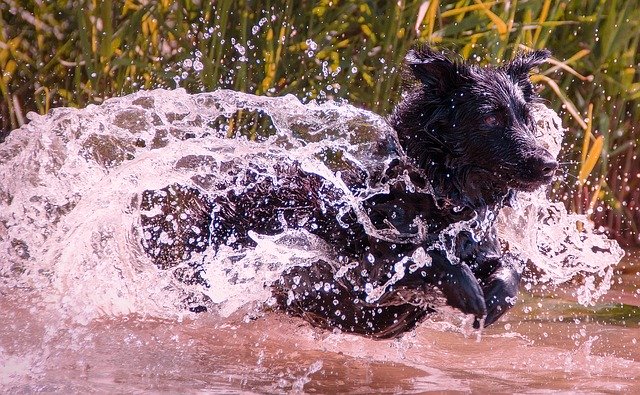
Whilst many dogs enjoy swimming as a form of exercise, not all dogs are confident swimmers, and many can’t swim at all.
Don’t be mistaken, your dog may sport a thicker coat, webbed toes and a sturdy build, which enables him to swim with stamina, but even so, he may not enjoy swimming out of his depth.
Teaching your dog to be a competent swimmer
Swimming can be great at building your dog’s muscles and strength, it can also be good for stiff and painful joints and can help cool your dog down on a hot day.
Even if your dog seems keen, he’ll need to learn how to swim. Be prepared to take it slowly when introducing your dog to water. Initially keep your dog on his lead and allow him to get his paws wet, staying in the shallow area at first.
It may be an idea to use treats and toys to make splashing in shallow water fun.
If your dog is reluctant, use a positive tone of voice and lots of verbal praise to encourage his progress. Observe his body language to make sure that he’s happy and confident, before gradually moving into deeper water.
Once ready, encourage your dog to move out of their depth to start paddling, you can use an arm to provide a little extra support under your dog’s belly if he needs it. This gives him the incentive to paddle his rear legs along with the front legs – paddling with front legs alone will mean he tires easily and splashes excessively.
After a few minutes, encourage your dog back to the shore so he knows how to get out of the water. If at any point he appears to be panicking, back up into the shallow water and let him calm down before trying again.
Never leave your dog unattended around water or push him to do anything that he doesn’t want to do, even if he is a strong swimmer.
The best and worst swimming spots
Some places are much safer for your dog to swim than others.
The Best
There are good swimming spots that pose little or no threat to dogs, assuming that your dog is able to swim. These include:
- Lakes
- Sea swimming
- Slow moving rivers
- Private swimming pools
- Paddling pools.
All of the above offer calm waters. Lakes often have plenty of safe, shallow areas for your dog to swim in too. Dog friendly beaches can provide an enjoyable way for you dog to splash and stay cool – be sure not to visit when the sand is too hot for their paws though. Shallow, slow moving rivers can be safe but always check for hidden dangers, such as fallen trees and rubbish in the water.
If you have access to a private pool then firstly, we’re very jealous, and secondly, providing the water doesn’t get too deep and cold (be sure to watch your dog in the water), these are fabulous places for your dog to enjoy a swim. Wash any chlorine off their fur when they finally climb out.
If you opt for a paddling pool in the garden, this can be a great way for your dog to both have fun splashing in the water and cool down on a hot day. You may want to look for one with hard sides to prevent tears from claws.
The worst
Other areas of water can pose serious dangers to your dog. These are:
- Canals
- Reservoirs
- Rough seas
- Fast flowing water or flooded rivers.
Canals can contain stagnant water and also hidden dangers, such as rubbish, which can also be found in reservoirs. Reservoirs can also be very deep and therefore the water can be extremely cold, which can shock your dog.
Both reservoirs and fast flowing water or flooded rivers can have fast flowing, strong currents that can sweep your dog away quickly and hinder their ability to get back onto dry land safely. Rough seas similarly have strong waves and fast water, posing a high risk to your dog.
Gundogs and water on shoot days
If you own a working gundog, you may not be aware of water dangers until the day of a shoot.
Any unnecessary dangers should be avoided on shoot days. If you feel that water could pose a threat, speak to other members of the picking-up team and also the Shoot Captain. If risks are considered responsibly and you are confident that you can control your dog, should he go near to or enter the water, then there is no reason not to proceed with the shoot as planned, assuming you have trained your dog to be a confident swimmer.
You must, however, proceed on high alert and be confident that your dog will respond immediately, should you need to abort the retrieve for safety reasons.
Additional dangers in the water
There are some diseases and poisons that can affect your dog if they’ve been swimming. You can help keep your dog safe by picking a good swimming spot and staying up-to-date with their vaccinations:
Leptospirosis is an infection spread through rat wee and contaminated water. There’s a vaccination to protect your dog against leptospirosis. You can also reduce the risk of your dog catching this by avoiding stagnant water and canals – some lakes can contain stagnant water too, so be cautious, even in safe places.
Blue-green algae is also found in stagnant water and looks like a blue-green sheen on the surface. Sadly, these algae can be very toxic to your dog – if you think they have come into contact with blue-green algae, prevent them from licking their fur, rinse them down if you are able to but most importantly, get them to your vet immediately. Lakes in community spaces and natures reserves will generally have signs up to inform dog owners if blue-green algae are present, so be sure to look out for any warning signs on show in these areas.
Top Tips
Give your dog a good wash when they return home from a swim to be sure their fur is clean of anything they might have picked up in the water.
If your dog gets into trouble in the water, don’t go in after them, as tempting as this will be. Ring 999 instead and get help from the professionals – don’t put yourself in danger.
To summarise
With a little patience, you can teach your dog to be a strong, confident swimmer.
There are plenty of safe places for your dog to splash and enjoy the water and some spots that you should avoid altogether, if possible. Both may have hidden dangers and toxic diseases and poisons present so be cautious when assessing a water spot and always watch your dog whilst they are in the water.
As long as you are confident water is being considered responsibly on a shoot day and that your dog will respond immediately to your recall, if necessary, then there is no reason not to proceed with your day.
Always wash your dog thoroughly after they have been in water and never jump in after him if he gets into danger – you may put your own life at risk in doing so.



